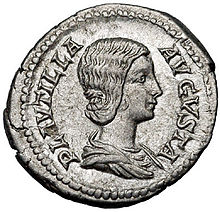Fulvia Plautilla
| Fulvia Plautilla | |||||||||
|---|---|---|---|---|---|---|---|---|---|
| Augusta | |||||||||
 Bust of Plautilla, Museo Nazionale Romano.[1] | |||||||||
| Roman empress | |||||||||
| Tenure | 202–205 (with Julia Domna) | ||||||||
| Died | 211 Lipari | ||||||||
| Spouse | Caracalla | ||||||||
| Issue | possible daughter | ||||||||
| |||||||||
| Father | Gaius Fulvius Plautianus | ||||||||
| Mother | Hortensia | ||||||||
Publia Fulvia Plautilla (died 211) was the wife of the Roman emperor Caracalla, her paternal second cousin. After her father was condemned for treason, she was exiled and eventually killed, possibly on Caracalla's orders.[2][3]
Life
Plautilla was born and raised in Rome. She belonged to the gens Fulvia of ancient Rome. The Fulvius family was of plebeian origin, came from Tusculum, Italy and had been active in politics since the Roman Republic. Plautilla's father, however, came from the Leptis Magna, in North Africa (located in modern-day Libya).[4]
Her mother was named Hortensia; her father was Gaius Fulvius Plautianus, the Commander of the Praetorian Guard, consul, paternal first cousin and close ally to Roman Emperor Lucius Septimius Severus (the father of Caracalla). She also had a brother, Gaius Fulvius Plautius Hortensianus.
Severus and Plautianus arranged for Plautilla to be married to Severus' son and heir, Caracalla, in a lavish ceremony in April 202 CE.[5][6] The forced marriage proved to be very unhappy; Caracalla despised her.[2] According to Cassius Dio, Plautilla had a profligate character; however, scholars view this as most likely being a claim driven by propaganda.[3][6]
Numismatic evidence may indicate that Plautilla and Caracalla had a daughter, whose name is unknown, in 204.[7][8] Anthony Birley notes that these coins "may indicate no more than pious hopes" and doubts that the marriage was consummated.[9]
In the same year, her father-in-law ordered the erection of the Arch of Septimius Severus, honoring him and his family, including his wife, Empress Julia Domna, Caracalla, Plautilla and her brother-in-law Publius Septimius Geta.

On 22 January 205 Gaius Fulvius Plautianus was executed for treachery and his family properties were confiscated. Plautilla and her brother were exiled by Caracalla to Sicily and then to Lipari.[2] They were treated very harshly and were eventually strangled, possibly on Caracalla's orders after the death of Septimius Severus on 4 February 211.
Contemporary depictions
Coins bearing her image that have survived are mainly from the reign of her father-in-law. They are inscribed Plautilla Augusta or Plautillae Augustae.
A marble bust of Fulvia Plautilla is in the Louvre.[10]
The Solinjanka or Salonitanka, meaning "woman from the city of Solin (ancient Salona)", one of the most important Roman portraits found in Croatia, is believed to depict Plautilla at a young age.[11][12] Originally found in Salona, it is now kept in the Archaeological museum in Zagreb.
Severan dynasty family tree
Severan family tree | |||||||||||||||||||||||||||||||||||||||||||||||||||||||||||||||||||||||||||||||||||||||||||||||||||||||||||||||||||||||||||||||||||||||||||||||||||||||||||||||||||||||||||||||||||||||||||||||||||||||||||||||||||||||||||||||||||||||||||||||||||||||||||||||||||||||||||||||||||||||||||||||||||||||||||||||||||||||||||||||||||||||||||||||||||||||||||||||||||||||||||||||||||||||||||||||||||||||||||||||||||||||||||||||||||||||||||||||||||||||||||||||||||||||||||||||||||||||||||||||||||||||||||||||||||||||||||||||||||||||||||||||||||||||||||||||||||||||||||||||||||||||||||||||||||||||||||||||||||||||||||||||||||||||||||||||||||||||||||||||||||||||||||||||||||||||||||||||||||||||||||||||||||||||||||||||||||||||||||||||||||||||||||||||||||||||||||||||||||||||||||||||||||||||||||||||||||||||||||||||||||||||||||||||||||||||||||||||||||||||||||||||||||||||||||||||||||||||||||||||||||||||||||||||||||||||||||||||||||||||||||||||||||||||||||||||||||||||||||
|---|---|---|---|---|---|---|---|---|---|---|---|---|---|---|---|---|---|---|---|---|---|---|---|---|---|---|---|---|---|---|---|---|---|---|---|---|---|---|---|---|---|---|---|---|---|---|---|---|---|---|---|---|---|---|---|---|---|---|---|---|---|---|---|---|---|---|---|---|---|---|---|---|---|---|---|---|---|---|---|---|---|---|---|---|---|---|---|---|---|---|---|---|---|---|---|---|---|---|---|---|---|---|---|---|---|---|---|---|---|---|---|---|---|---|---|---|---|---|---|---|---|---|---|---|---|---|---|---|---|---|---|---|---|---|---|---|---|---|---|---|---|---|---|---|---|---|---|---|---|---|---|---|---|---|---|---|---|---|---|---|---|---|---|---|---|---|---|---|---|---|---|---|---|---|---|---|---|---|---|---|---|---|---|---|---|---|---|---|---|---|---|---|---|---|---|---|---|---|---|---|---|---|---|---|---|---|---|---|---|---|---|---|---|---|---|---|---|---|---|---|---|---|---|---|---|---|---|---|---|---|---|---|---|---|---|---|---|---|---|---|---|---|---|---|---|---|---|---|---|---|---|---|---|---|---|---|---|---|---|---|---|---|---|---|---|---|---|---|---|---|---|---|---|---|---|---|---|---|---|---|---|---|---|---|---|---|---|---|---|---|---|---|---|---|---|---|---|---|---|---|---|---|---|---|---|---|---|---|---|---|---|---|---|---|---|---|---|---|---|---|---|---|---|---|---|---|---|---|---|---|---|---|---|---|---|---|---|---|---|---|---|---|---|---|---|---|---|---|---|---|---|---|---|---|---|---|---|---|---|---|---|---|---|---|---|---|---|---|---|---|---|---|---|---|---|---|---|---|---|---|---|---|---|---|---|---|---|---|---|---|---|---|---|---|---|---|---|---|---|---|---|---|---|---|---|---|---|---|---|---|---|---|---|---|---|---|---|---|---|---|---|---|---|---|---|---|---|---|---|---|---|---|---|---|---|---|---|---|---|---|---|---|---|---|---|---|---|---|---|---|---|---|---|---|---|---|---|---|---|---|---|---|---|---|---|---|---|---|---|---|---|---|---|---|---|---|---|---|---|---|---|---|---|---|---|---|---|---|---|---|---|---|---|---|---|---|---|---|---|---|---|---|---|---|---|---|---|---|---|---|---|---|---|---|---|---|---|---|---|---|---|---|---|---|---|---|---|---|---|---|---|---|---|---|---|---|---|---|---|---|---|---|---|---|---|---|---|---|---|---|---|---|---|---|---|---|---|---|---|---|---|---|---|---|---|---|---|---|---|---|---|---|---|---|---|---|---|---|---|---|---|---|---|---|---|---|---|---|---|---|---|---|---|---|---|---|---|---|---|---|---|---|---|---|---|---|---|---|---|---|---|---|---|---|---|---|---|---|---|---|---|---|---|---|---|---|---|---|---|---|---|---|---|---|---|---|---|---|---|---|---|---|---|---|---|---|---|---|---|---|---|---|---|---|---|---|---|---|---|---|---|---|---|---|---|---|---|---|---|---|---|---|---|---|---|---|---|---|---|---|---|---|---|---|---|---|---|---|---|---|---|---|---|---|---|---|---|---|---|---|---|---|---|---|---|---|---|---|---|---|---|---|---|---|---|---|---|---|---|---|---|---|---|---|---|---|---|---|---|---|---|---|---|---|---|---|---|---|---|---|---|---|---|---|---|---|---|---|---|---|---|---|---|---|---|---|---|---|---|---|---|---|---|---|---|---|---|---|---|---|---|---|---|---|---|---|---|---|---|---|---|---|---|---|---|---|---|---|---|---|---|---|---|---|---|---|---|---|---|---|---|---|---|---|---|---|---|---|---|---|---|---|---|---|---|---|---|---|---|---|---|---|---|---|---|---|---|---|---|---|---|---|---|---|---|---|---|---|---|---|---|---|---|---|---|---|---|---|---|---|---|---|---|---|---|---|---|---|---|---|---|---|---|---|---|---|---|---|---|---|---|---|---|---|---|---|---|---|---|---|---|---|---|---|---|---|---|---|---|---|---|---|---|---|---|---|---|---|---|---|---|---|---|---|---|---|---|---|---|---|---|---|---|---|---|---|---|---|---|---|---|---|---|---|---|---|---|---|---|---|---|---|---|---|---|---|---|---|---|---|---|---|---|---|---|---|---|---|---|---|---|---|---|---|---|
| |||||||||||||||||||||||||||||||||||||||||||||||||||||||||||||||||||||||||||||||||||||||||||||||||||||||||||||||||||||||||||||||||||||||||||||||||||||||||||||||||||||||||||||||||||||||||||||||||||||||||||||||||||||||||||||||||||||||||||||||||||||||||||||||||||||||||||||||||||||||||||||||||||||||||||||||||||||||||||||||||||||||||||||||||||||||||||||||||||||||||||||||||||||||||||||||||||||||||||||||||||||||||||||||||||||||||||||||||||||||||||||||||||||||||||||||||||||||||||||||||||||||||||||||||||||||||||||||||||||||||||||||||||||||||||||||||||||||||||||||||||||||||||||||||||||||||||||||||||||||||||||||||||||||||||||||||||||||||||||||||||||||||||||||||||||||||||||||||||||||||||||||||||||||||||||||||||||||||||||||||||||||||||||||||||||||||||||||||||||||||||||||||||||||||||||||||||||||||||||||||||||||||||||||||||||||||||||||||||||||||||||||||||||||||||||||||||||||||||||||||||||||||||||||||||||||||||||||||||||||||||||||||||||||||||||||||||||||||||
Notes:
Bibliography:
| |||||||||||||||||||||||||||||||||||||||||||||||||||||||||||||||||||||||||||||||||||||||||||||||||||||||||||||||||||||||||||||||||||||||||||||||||||||||||||||||||||||||||||||||||||||||||||||||||||||||||||||||||||||||||||||||||||||||||||||||||||||||||||||||||||||||||||||||||||||||||||||||||||||||||||||||||||||||||||||||||||||||||||||||||||||||||||||||||||||||||||||||||||||||||||||||||||||||||||||||||||||||||||||||||||||||||||||||||||||||||||||||||||||||||||||||||||||||||||||||||||||||||||||||||||||||||||||||||||||||||||||||||||||||||||||||||||||||||||||||||||||||||||||||||||||||||||||||||||||||||||||||||||||||||||||||||||||||||||||||||||||||||||||||||||||||||||||||||||||||||||||||||||||||||||||||||||||||||||||||||||||||||||||||||||||||||||||||||||||||||||||||||||||||||||||||||||||||||||||||||||||||||||||||||||||||||||||||||||||||||||||||||||||||||||||||||||||||||||||||||||||||||||||||||||||||||||||||||||||||||||||||||||||||||||||||||||||||||||
References
- ^ Motta, Rosa Maria (2015). Material Culture and Cultural Identity: A Study of Greek and Roman Coins from Dora. Archaeopress Publishing. p. 53. ISBN 978-1-78491-093-8.
- ^ a b c Sellars, Ian J. (2013-10-28). The Monetary System of the Romans: A description of the Roman coinage from early times to the reform of Anastasius. Ian J. Sellars.
- ^ a b Kelly, Benjamin; Hug, Angela (2022-10-20). The Roman Emperor and his Court c. 30 BC–c. AD 300: Volume 2, A Sourcebook. Cambridge University Press. ISBN 978-1-009-08173-3.
- ^ Sear, David (2002-12-31). Roman Coins and Their Values Volume 2. Spink & Son, Ltd. ISBN 978-1-912667-23-9.
- ^ Boatwright, Mary T. (2021-05-20). Imperial Women of Rome: Power, Gender, Context. Oxford University Press. ISBN 978-0-19-756703-6.
- ^ a b Vagi, David L. (2000). Coinage and History of the Roman Empire, C. 82 B.C.--A.D. 480: History. Taylor & Francis. ISBN 978-1-57958-316-3.
- ^ Townsend, Prescott W. (1938). "The Significance of the Arch of the Severi at Lepcis". American Journal of Archaeology. 42 (4): 512–524. doi:10.2307/499184. JSTOR 499184. S2CID 191360886.
- ^ Mattingly, Harold (1936). The Roman Imperial Coinage: pt. 1. Pertinax to Geta, by H. Mattingly and E. A. Sydenham. pt. 2. Macrinus to Pupienus, by H. Mattingly, E. A. Sydenham, and C. H. V. Sutherland. pt. 3. Gordian III-Uranius Antonius, by H. Mattingly. Spink. p. 78.
- ^ Birley, Anthony (1999). Septimius Severus : the African emperor. London: Routledge. p. 161. ISBN 9780415165914.
- ^ History of Rome and of the Roman people (from its origin to the invasion of the barbarians), Victor Duruy and John Pentland Mahaffey, C.F. Jewett Publishing Company, 1883, pg. 535.
- ^ The Greek and Roman Collection Archived 2013-02-14 at the Wayback Machine, Web page of Archaeological museum in Zagreb.
- ^ Plautilla and the Fate of a Princess, Archaeologia Adriatica 11 (2008), 473-488 (Article in Croatian; showing portrait).
External links

- http://www.treasurerealm.com/coinpapers/romanemperors/plautilla.html
- https://web.archive.org/web/20070928092559/http://vessels-of-time.com/women_of_rome.htm
- http://www.roman-emperors.org/caracala.htm#Note_pfp
- https://web.archive.org/web/20070907023111/http://www.forumancientcoins.com/historia/coins/r4/r1461.htm
- http://penelope.uchicago.edu/Thayer/E/Gazetteer/Places/Europe/Italy/Lazio/Roma/Rome/_Texts/PLATOP*/Arcus_Argentariorum.html
- http://www.trajancoins.com/plautilla.htm
- "Dictionary of Greek and Roman Biography and Mythology, p. 405". Archived from the original on 27 February 2015.
- Marble portrait of Plautilla kept in Archaeological museum in Zagreb. Archived 2013-10-14 at the Wayback Machine
| Royal titles | ||
|---|---|---|
| Preceded by | Empress of Rome 202–205 with Julia Domna (202–205) | Succeeded by |










